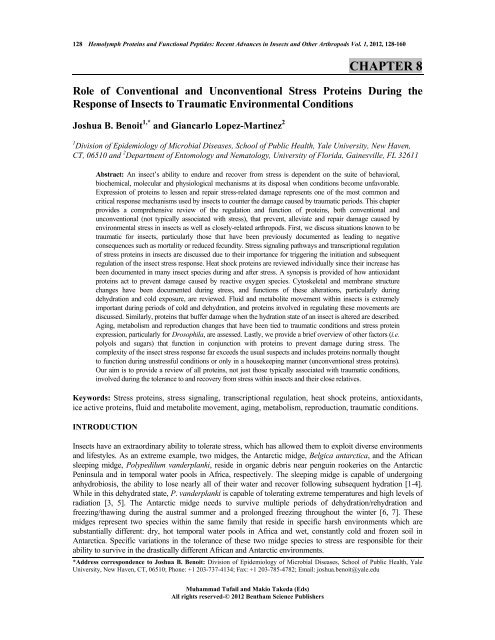chapter 1 - Bentham Science
chapter 1 - Bentham Science
chapter 1 - Bentham Science
You also want an ePaper? Increase the reach of your titles
YUMPU automatically turns print PDFs into web optimized ePapers that Google loves.
128 Hemolymph Proteins and Functional Peptides: Recent Advances in Insects and Other Arthropods Vol. 1, 2012, 128-160<br />
Muhammad Tufail and Makio Takeda (Eds)<br />
All rights reserved-© 2012 <strong>Bentham</strong> <strong>Science</strong> Publishers<br />
CHAPTER 8<br />
Role of Conventional and Unconventional Stress Proteins During the<br />
Response of Insects to Traumatic Environmental Conditions<br />
Joshua B. Benoit 1,* and Giancarlo Lopez-Martinez 2<br />
1 Division of Epidemiology of Microbial Diseases, School of Public Health, Yale University, New Haven,<br />
CT, 06510 and 2 Department of Entomology and Nematology, University of Florida, Gainesville, FL 32611<br />
Abstract: An insect’s ability to endure and recover from stress is dependent on the suite of behavioral,<br />
biochemical, molecular and physiological mechanisms at its disposal when conditions become unfavorable.<br />
Expression of proteins to lessen and repair stress-related damage represents one of the most common and<br />
critical response mechanisms used by insects to counter the damage caused by traumatic periods. This <strong>chapter</strong><br />
provides a comprehensive review of the regulation and function of proteins, both conventional and<br />
unconventional (not typically associated with stress), that prevent, alleviate and repair damage caused by<br />
environmental stress in insects as well as closely-related arthropods. First, we discuss situations known to be<br />
traumatic for insects, particularly those that have been previously documented as leading to negative<br />
consequences such as mortality or reduced fecundity. Stress signaling pathways and transcriptional regulation<br />
of stress proteins in insects are discussed due to their importance for triggering the initiation and subsequent<br />
regulation of the insect stress response. Heat shock proteins are reviewed individually since their increase has<br />
been documented in many insect species during and after stress. A synopsis is provided of how antioxidant<br />
proteins act to prevent damage caused by reactive oxygen species. Cytoskeletal and membrane structure<br />
changes have been documented during stress, and functions of these alterations, particularly during<br />
dehydration and cold exposure, are reviewed. Fluid and metabolite movement within insects is extremely<br />
important during periods of cold and dehydration, and proteins involved in regulating these movements are<br />
discussed. Similarly, proteins that buffer damage when the hydration state of an insect is altered are described.<br />
Aging, metabolism and reproduction changes that have been tied to traumatic conditions and stress protein<br />
expression, particularly for Drosophila, are assessed. Lastly, we provide a brief overview of other factors (i.e.<br />
polyols and sugars) that function in conjunction with proteins to prevent damage during stress. The<br />
complexity of the insect stress response far exceeds the usual suspects and includes proteins normally thought<br />
to function during unstressful conditions or only in a housekeeping manner (unconventional stress proteins).<br />
Our aim is to provide a review of all proteins, not just those typically associated with traumatic conditions,<br />
involved during the tolerance to and recovery from stress within insects and their close relatives.<br />
Keywords: Stress proteins, stress signaling, transcriptional regulation, heat shock proteins, antioxidants,<br />
ice active proteins, fluid and metabolite movement, aging, metabolism, reproduction, traumatic conditions.<br />
INTRODUCTION<br />
Insects have an extraordinary ability to tolerate stress, which has allowed them to exploit diverse environments<br />
and lifestyles. As an extreme example, two midges, the Antarctic midge, Belgica antarctica, and the African<br />
sleeping midge, Polypedilum vanderplanki, reside in organic debris near penguin rookeries on the Antarctic<br />
Peninsula and in temporal water pools in Africa, respectively. The sleeping midge is capable of undergoing<br />
anhydrobiosis, the ability to lose nearly all of their water and recover following subsequent hydration [1-4].<br />
While in this dehydrated state, P. vanderplanki is capable of tolerating extreme temperatures and high levels of<br />
radiation [3, 5]. The Antarctic midge needs to survive multiple periods of dehydration/rehydration and<br />
freezing/thawing during the austral summer and a prolonged freezing throughout the winter [6, 7]. These<br />
midges represent two species within the same family that reside in specific harsh environments which are<br />
substantially different: dry, hot temporal water pools in Africa and wet, constantly cold and frozen soil in<br />
Antarctica. Specific variations in the tolerance of these two midge species to stress are responsible for their<br />
ability to survive in the drastically different African and Antarctic environments.<br />
*Address correspondence to Joshua B. Benoit: Division of Epidemiology of Microbial Diseases, School of Public Health, Yale<br />
University, New Haven, CT, 06510; Phone: +1 203-737-4134; Fax: +1 203-785-4782; Email: joshua.benoit@yale.edu

















